Dive Bombers: American Olympians defeated Axis Powers in peace & war

This story appears in the May 25, 2015 issue of Sports Illustrated. To subscribe, click here.
They were early aerialists, twisting and spinning and knifing in free fall. They had a sixth sense for midair navigation, knew tricks to outwit gravity—or at least suspend it for a while.
Ocean travel? Slogging through that unpredictable chop? That was something else entirely. So when the SS Manhattan, a 24,000-ton luxury liner, left Pier 60 on Manhattan's West Side on July 15, 1936, it didn't take long for Frank Kurtz and Marshall Wayne to become seasick.
Bound for Berlin, they were friends and teammates on the U.S. diving delegation to the 1936 Summer Olympics. They traveled with 382 other athletes and roughly the same number of staff members and plenipotentiaries. (In one of the many signs of the time, the officials and coaches stayed in plush cabins while the athletes were exiled to steerage.) As New York's skyline receded from view—and Kurtz and Wayne started to get queasy—it became official: The U.S. was sending a full team to the Games of the 11th Olympiad. Or, as they would be called, Hitler's Games.
Until the ship's departure, there had been spirited debate among politicians and sports officials over whether the U.S. should boycott an event that would glorify Nazi Germany. Adolf Hitler's regime had already instituted the Nuremberg race laws, which deprived German Jews of the rights of citizenship and forbade them to marry or even have romantic relations with Aryans. The official Nazi newspaper, the Völkischer Beobachter, advocated that Jews and blacks not be allowed to compete in the Olympics.
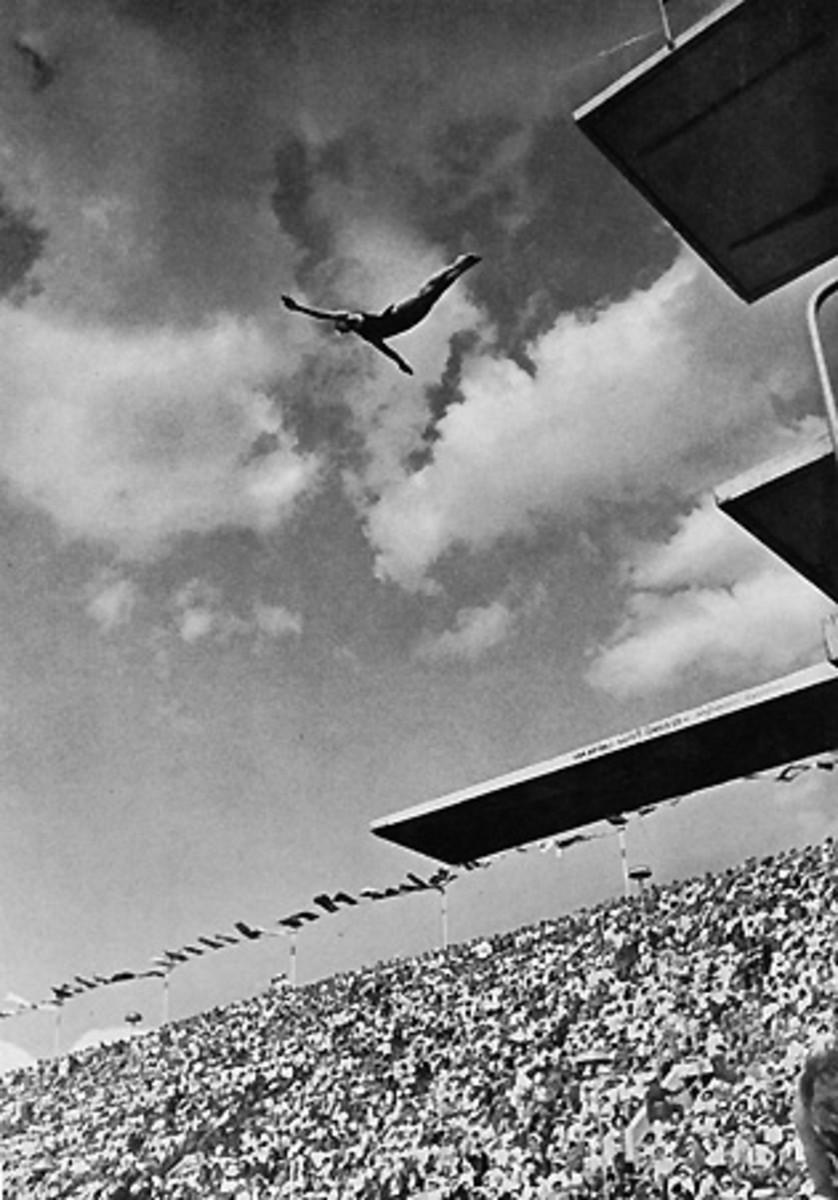
But Avery Brundage, the president of the American Olympic Committee, demanded that the U.S. take part. He believed that politics and sports shouldn't mix and that the U.S. should not involve itself in what he blithely called the "Jew-Nazi altercation." Without apparent irony, Brundage said, "The very foundation of the modern Olympic revival will be undermined if individual countries are allowed to restrict participation by reason of class, creed or race."
Despite the rough seas and stormy weather, the nine-day crossing of the Atlantic gave the U.S. squads a chance to bond. Pamphlets distributed to athletes encouraged them to mingle: "You are among the chosen youth of the world who will cement new friendships by your esprit de corps." Conviviality reigned on the ship—too much so in the case of Eleanor Holm, a top swimmer who reportedly drank herself silly one time too many and was banned by Brundage from competing in the Games.
Louis Zamperini, the 5,000-meter runner whose story would be told in Unbroken, became pals with Kurtz and Wayne. The two divers cut remarkably similar figures. Both 24, they were fierce individualists who carried themselves with casual grace—young men seemingly born with the instruction manual for life. They valued experiences (and the rollicking stories that were their by-products) over money or fame.
By the time the U.S. teams arrived in Berlin, this was clear: Hitler did indeed intend to use the Games as propaganda. Anti-Semitic posters and pamphlets had disappeared. At gunpoint, Gypsies had been cleared from the streets and interned at a camp on the outskirts of town. Spending an unprecedented $30 million, Hitler had built a lavish athletes' village, a half-dozen Olympic venues, and a track and field stadium that seated more than 100,000. The Führer also commissioned his favorite filmmaker, Leni Riefenstahl, to chronicle the spectacle. Her work, Olympia, which would be considered a groundbreaking documentary, emphasized the physical form, particularly among German athletes.
Hitler spoke at the opening ceremonies, on Aug. 1, beneath swastika flags, peace pigeons and the Hindenburg blimp. Once competition began, he pinballed from event to event. He took sharp interest in the men's diving, in which he expected a German, Hermann Stork, to take gold in the 10-meter platform. The Wasserspringen team was coached by an American, Harold (Dutch) Smith, who was supposed to lead a medals sweep in the two events, the platform and the three-meter springboard.
The U.S., though, proved dominant. In fact, were it not for the heroics (and attendant social drama) of Jesse Owens on the track, the American men's divers might have been the darlings of the Games. The team drank prodigiously, walked with chests puffed out, stole Nazi flags as pranks and won five of the six medals. Stork took only a bronze in the platform, while Wayne earned gold in that event and silver in the springboard. And, figuring he had the equivalent of diplomatic immunity, Wayne is said to have denounced fascism to the Führer's face.
In a few years Kurtz and Wayne would be back on the righthand side of the Atlantic, still making history. Among the greatest in the Greatest Generation—Übermenschen, the Germans might have called them—they competed once more against Hitler. This time at higher altitude.
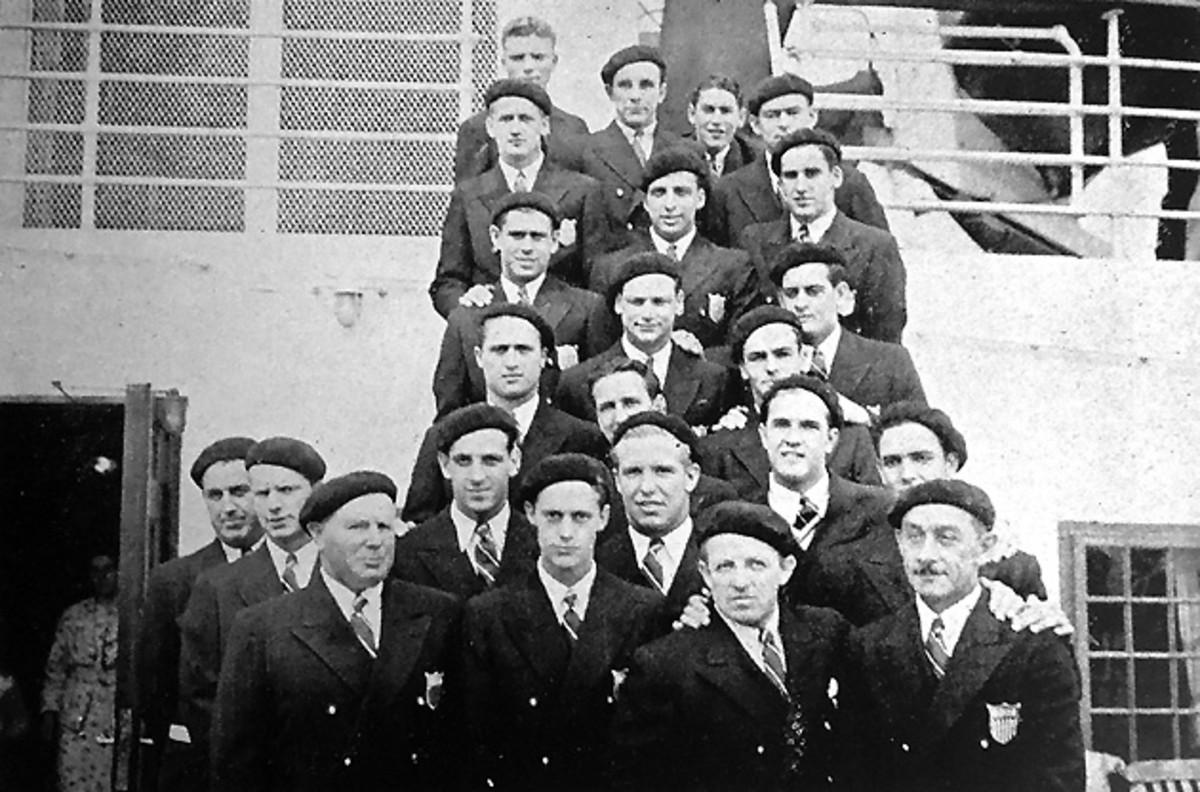
*****
Frank Kurtz didn't have a childhood so much as a series of unlikely adventures beginning at an early age. At 10, when his parents divorced, he moved with his mother from the Quad Cities to Kansas City, Mo. One day at the pool he saw a way to turn his body into a projectile. The freckle-faced kid tugged at the lifeguard's swimsuit. "I don't know how to swim, Mister, but I want to dive off of that board," he said. "Will you catch me?" When Frank broke the surface of the water, he thought, That sure was fun. He dived again and again, adding twists.
Two years later Frank ran away from home to escape beatings from his stepfather. First he stayed in Kansas City, frequenting the pool at the Kansas City Athletic Club, earning money as a paperboy and never wanting for a meal or a bed. As Kurtz's wife, Margo, put it decades later, "People liked having him around so much, he could always find someone to take him in."
When Frank was 14, Johnny Weissmuller, the Olympic swimming champ—and later Tarzan portrayer—made an appearance at the KCAC. He saw Frank dive and, spotting potential, told him that if he really wanted to improve, he should find a top-notch coach, such as Clyde Swendsen at the Hollywood Athletic Club. That was all Frank needed to hear. He hitchhiked west, tracked down Swendsen and became his prized student. Though slight of build, Frank was fearless and had impeccable technique. Soon he was winning junior championships.
Just as he had in Kansas City, Frank found immediate favor with the club's members, many of them studio executives and business titans. He grew especially close to Frank Bireley, an orange-soda magnate and flying enthusiast who was a friend of Amelia Earhart's. Bireley taught Frank how to fly, mostly in a 120-horsepower biplane named Yankee Boy. By the time Frank graduated from Hollywood High, in 1931, he held a slew of junior world flying records, including fastest land speed (152 mph) and swiftest flight from Mexico City to New York City. He was the subject of a Popular Science magazine feature titled DAREDEVIL BOY PILOT. Kurtz, it said, "might well be called the Lindbergh of the younger aviators."
But in his other soaring ambition, to make the Olympic diving team, Kurtz had a harder time achieving lift-off. He was told that an older diver from Egypt, Farid Simaika, a silver and bronze medalist at the 1928 Games, would represent the Hollywood Athletic Club at the AAU national championship, a precursor to the '32 Olympic trials. Kurtz was welcome to attend the meet—on his own dime. The event was in Honolulu.
Were it not for the heroics of Jesse Owens on the track, the American men's divers might have been the darlings of the game.
To Kurtz that was only a minor inconvenience. He signed on as a seaman aboard a tanker and arrived in Hawaii just in time to enter. He placed second and promptly disappeared. To get back to L.A., he had sneaked aboard a steamer called the Malolo. One newspaper headlined the wire story DIVING STAR IS STOWAWAY. "Every passenger on the ship seemed conspiring to aid his clandestine passage," the article said, "with the result he slipped off the liner at port before officers were apprised of his presence."
Kurtz enrolled at USC, where he dived, studied aviation and met a co-ed named Margo Rogers. They would date for years and eventually marry. At the 1932 Olympics, which were held in Los Angeles, the diving competition took place on the USC campus. Kurtz took bronze in the 10-meter platform. Then he went back to school.
He also performed in traveling shows, doing dives that were trickier than those permitted by the Olympics. Watching the tryouts for the 1936 U.S. team, Grantland Rice, the sportswriting titan, rated Kurtz the greatest exhibition diver in the world. But Kurtz had suffered a shoulder injury in training aboard the boat to Berlin, according to Iris Critchell, a swimmer on the team, and one of his arms would be in a sling until two days before the competition. Team officials encouraged him to withdraw; why risk his career? Instead, Kurtz reset his sights: The fresher, healthier U.S. divers—Wayne chief among them—could finish first or second; he would go for third. As Margo would write in her 1945 memoir, My Rival, the Sky, "Frank told [U.S. officials] he thought he could push out the only real competitors the U.S. team had: the Germans and Japanese. He wanted to try to make it a clean American sweep ... so they let him dive."
Kurtz finished fifth in the platform and began looking toward 1940, when he could become the first U.S. diver to make three Olympic teams. But he left Berlin fearing the specter of another world war. "Last night," he wrote to Margo, who was home in the Midwest, "Mr. Hitler put on a show for all the visiting countries. You know, like Fourth of July night in the States, when we watch the pretty Roman candles break into the sky. But, Margo, it was a night of war. This Olympic arena in Berlin gave us war, and I didn't see one pretty Roman candle. The earth shook for miles in every direction, and each of us from every country sat there frozen to the seats, frozen by cold fear, while all Hell burst into the sky from that arena. I couldn't sleep all night, and I find this morning none of the boys could stop shaking long enough to sleep. If the purpose of these 'fireworks' was to scare us, Mr. Hitler has accomplished his mission. He has scared me."
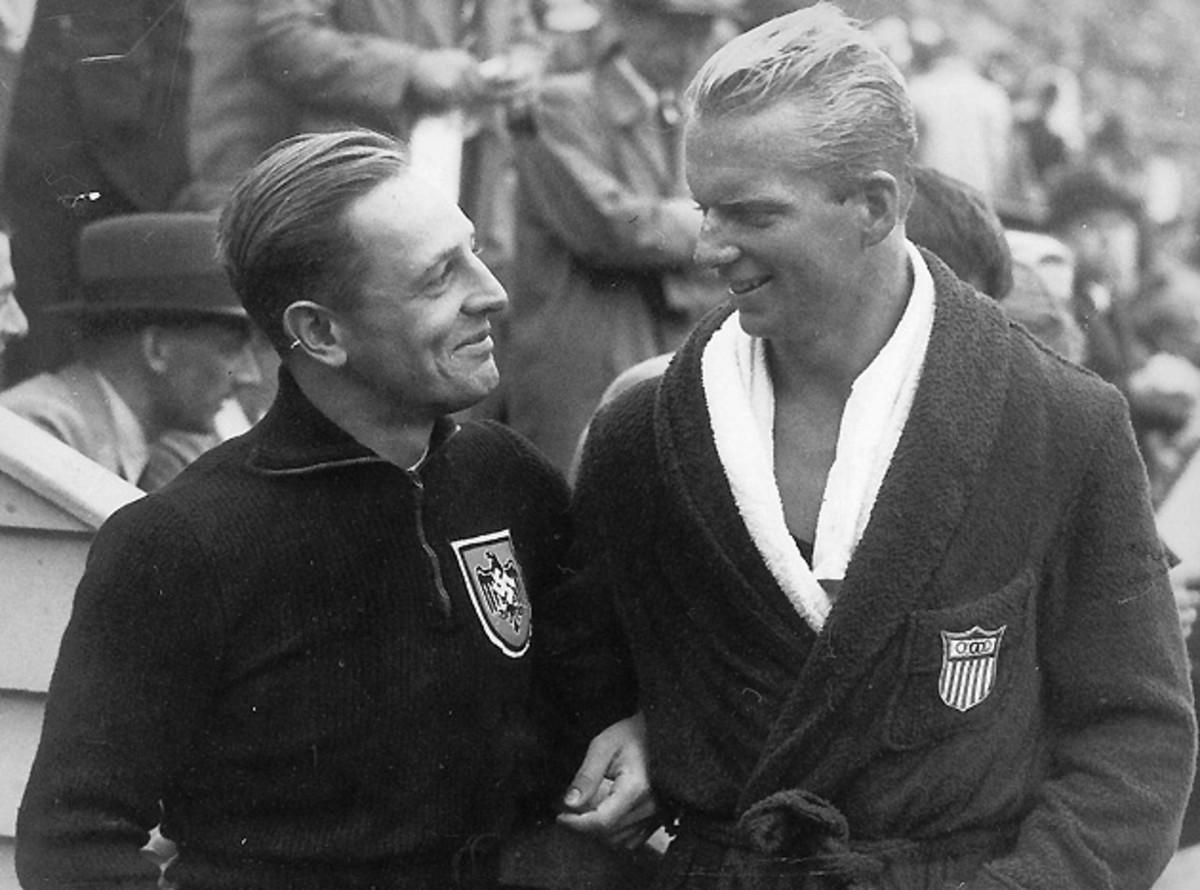
*****
As bright, athletic and modest as Marshall Wayne was, his appearance was what struck everyone most. The flowing blond hair. The blue eyes. The arms and legs, all definition and symmetry. "He would walk into a room, and heads would turn," recalls his sister, Dever Antes, now 100 years old. "The girls flocked to him."
Around the same time that Kurtz was learning to dive in Southern California, Wayne was taking to the sport in South Florida. His parents worked in a vaudeville troupe, Wayne, Marshall & Candy, performing up and down the Eastern seaboard. Their only son among five children sometimes accompanied them, inoculating himself against stage fright at an early age. He was enthralled by the acrobats. Imitating their flips and twists, sometimes on a trampoline and sometimes on the Murphy bed in the family's apartment above a Miami Ford dealership, he discovered that the maneuvers weren't particularly hard to execute.
Marshall was a capable student at Miami Senior High, but while his parents toured, often leaving him under the supervision of a sister, he would escape school early (or take the day off) and head to the Venetian swimming pool, a 73-by-62-yard expanse in Coral Gables that served as an aquatic social hub. Orange Bowl queens were crowned there; one day in 1925, William Jennings Bryan showed up, floating on a pedestal and shilling for local real estate developers. Daily admission was 15 cents, but Marshall preferred to sneak in.
Already a strong swimmer, he used the diving board to attempt the acrobatic maneuvers he'd seen in vaudeville—and was immediately intoxicated. Soon Marshall was being invited to perform at private residences and at the Biltmore Hotel. As socialites nursed rum drinks and ate stone crabs, he performed stunt dives, showing off his flawless technique and physique. Sometimes he was paid, sometimes not. Former acquaintances speculate that the admiring attention was payment enough.
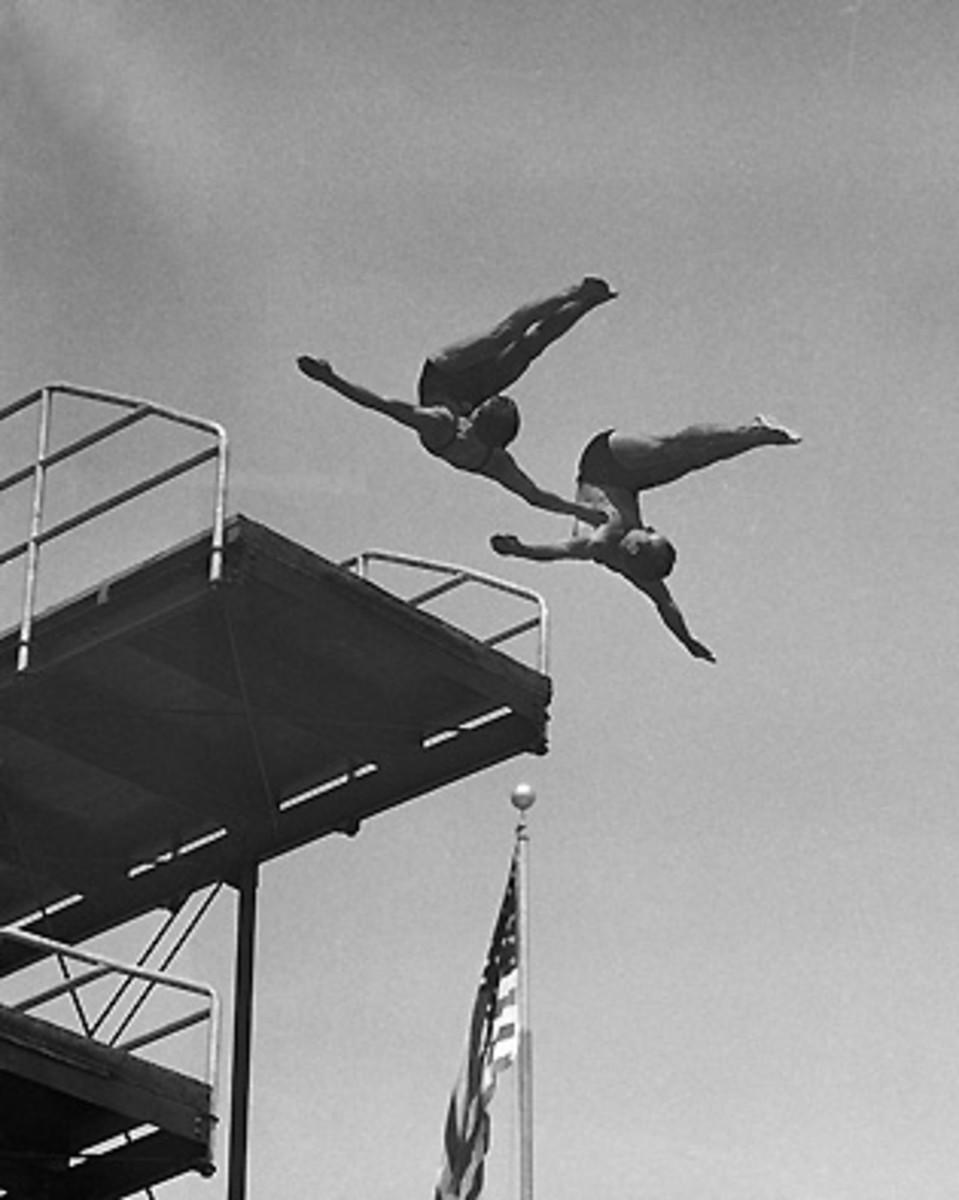
Though largely a diving autodidact, Marshall also worked with Don Grubbs, a majordomo of the Miami aquatics community. After high school the 6'2" Wayne competed for Miami in the early 1930s. For years he and a friendly rival, Dick Degener of Michigan, traded national amateur titles. At the '34 AAU championships in Columbus, Degener beat Wayne on his last dive. A year later, at the AAU outdoor event in Detroit, Wayne narrowly beat Degener.
Wayne kept his Olympic ambitions to himself. In 1936 he paid his own way to Des Moines and then Providence, R.I., for meets that doubled as trials for the Berlin Games. He did his best diving—especially on the three-meter board, on which he beat Kurtz, among others—and made the U.S. team. "We had no idea," says Dever, laughing. "He didn't tell anybody."
In Germany, Wayne's competitive instincts matched his skills. Before the diving events began, he and Degener watched the Japanese team practicing at the pool. At Wayne's suggestion, the Americans chose not to dive, sending a message to the opposition: We don't even need to warm up. Finally, on the day before the competition, Wayne casually pulled off a series of elaborate practice dives, each executed perfectly.
Wayne became a favorite of Riefenstahl's and was featured prominently in her documentary. One morning he was awakened at six to film a segment. "I could hardly stand on the platform," he recalled years later. "I was still partly seasick. I did the worst diving in that film I have ever seen.... My legs were like lead. All of ours were."
But in the Games, Wayne was a star. Watch video of him (available online), and you see a supremely confident athlete staring fixedly ahead. Then, in a symphonic fusion of grace and skill, he leaps off the board and cleaves the air. The list of permissible dives was limited compared with today's—the forward 2½ in pike position was perhaps the most difficult—and Wayne had executed more demanding ones in Miami exhibitions. He won the 10-meter platform, beating 25 other divers, and was just as sharp on the springboard. In the 1987 oral history Tales of Gold, by Lewis H. Carlson and John J. Fogarty, Wayne says that in the finals a Japanese diver "landed flat on his ass," but someone complained that the diver had been distracted by a commotion in the stands. Could he could take the dive over? Wayne and Degener looked at each other. "Yeah, let him do it all day and pick his best," Wayne said. Degener took gold, Wayne silver.
Before the competition began the Americans chose not to dive, sending a message: We don't even need to warm up.
Wayne joked that he had dived well enough to win only silver in the platform, but his Aryan features factored favorably with the judges and the German crowds. His sister recalls that when he phoned home from Europe, it wasn't until a few minutes into the conversation that he revealed that, yes, he'd done O.K. "To Marshall, it didn't amount to much," she says. "He was very, very modest."
He was also fiercely patriotic. If some athletes chose not to notice all the glorification of Nazism, Wayne was as disturbed by it as Kurtz. Accounts about his alleged confrontation of Hitler vary. In some it took place at the swimming venue; in others it occurred during the Führer's visit to the athletes' cafeteria. The New York Times noted that Wayne "riled Hitler," but it didn't provide specifics. "It was not very pleasant," says Dever Antes, who believes it happened at the diving venue. "Hitler was already mad that his man [Stork] didn't win and my brother did. Then Marshall told him off." Maybe the strongest evidence that the exchange occurred: Wayne, never prone to self-aggrandizement, recounted it when he returned.
Jesse Owens had already humiliated Hitler, serving as a one-man refutation of the theory of the Master Race, but the story that the Führer personally snubbed Owens after he won the 100 meters on the second day of the Games might be apocryphal. (Still, Kurtz perfected an imitation of Hitler, hands behind his back, abruptly snapping his body around, away from Owens.) While Owens and his four golds rightly became the central narrative of the 1936 Games, Tom Gompf, a South Florida diver who competed in the '64 Games and became the Miami diving coach, was moved by the story of Wayne's diving feats in Berlin. "Marshall Wayne," he says, "was every bit as important to diving and swimming as Jesse Owens was to track."
Wayne was quietly pleased with his performance and, like Kurtz, thrilled that the U.S. had beaten Germany and Japan, its adversaries in a bigger looming competition. He was sure that war was imminent, and that good would triumph over evil. "With what I've seen of the Germans in athletic competition," he would say in '43, "I am not in doubt as to the outcome of the war."
*****
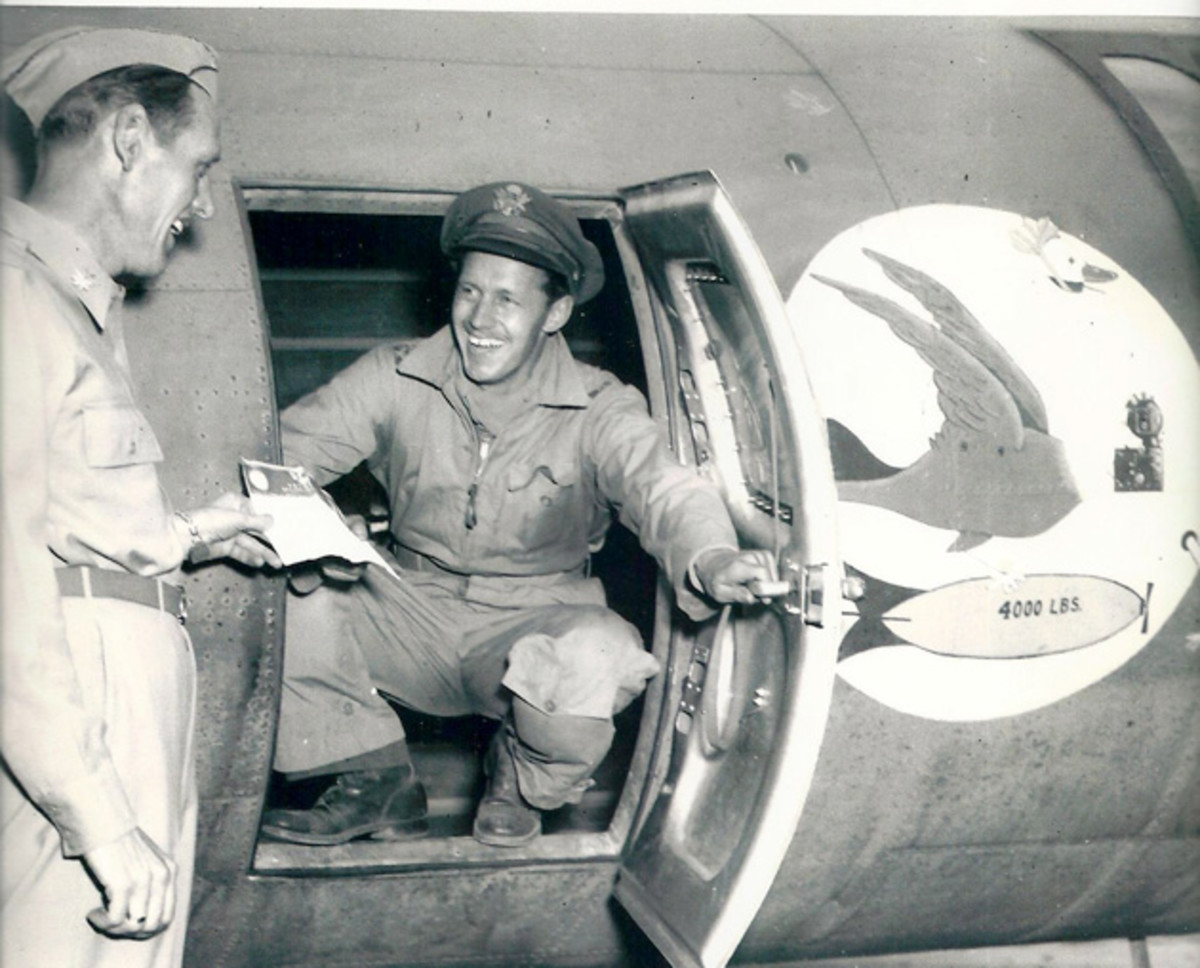
, aka Flying Fortresses. In December 1941, Kurtz was stationed at Clark Air Base in the Philippines, which was attacked by 70 Japanese bombers the day after Pearl Harbor. Kurtz had dug himself a foxhole, where he found refuge during the raid. Other airmen had not been so meticulous. Kurtz and a crewman were the only two of his 10-man team to survive.
Kurtz's bomber group relocated to Australia and patrolled the Pacific Theater. By turns attacking and avoiding the Japanese, Kurtz and his men flew 18 hours a day, with only catnaps between missions. During a bombing run on Borneo's eastern coast on Jan. 11, 1942, three enemy fighter planes mounted a 35-minute counterattack. Kurtz's crew shot down two of them.
While the B-17 escaped, it was badly damaged. Kurtz and his men repaired the plane, using scrap parts from other aircraft, and called their patchwork aircraft The Swoose, a nod to the chimerical half-swan, half-goose in the popular song "Alexander Is a Swoose." Kurtz flew the plane on hundreds of missions. The Swoose might have been the only B-17 that flew from the beginning to the end of World War II.
During his service in Australia, Kurtz shuttled around a brash young U.S. congressman from Texas, Lyndon B. Johnson. In an emergency landing in the Outback, Johnson became so panicked that he nearly soiled The Swoose. ("I don't care who you are," Kurtz is said to have yelled at Johnson. "Sit down! Otherwise you're just excess cargo!")
The mansion of an Australian publisher doubled as military headquarters. Kurtz regaled the publisher's 10-year-old son with tales of combat and pinned his air wings on the rapt kid. Kurtz didn't think about this until decades later, when the boy's name—Rupert Murdoch—came up in conversation.
In 1944, Kurtz volunteered to serve in Italy. He became commander of the 463rd Bombardment Group (Heavy), in Loggia, and flew 60 missions. He was known for reading books in the cockpit before heading off. Norman Lear, the Hollywood impresario, was a 20-year-old radio operator and gunner under Kurtz. "He had an enormous reputation, and we knew we were led by the best," Lear told People magazine. "He was a charismatic leader."
In 1944, Frank and Margo Kurtz became parents of a daughter, who would become a Broadway and Hollywood star. They could not resist naming her Swoosie, in honor of the plane. The Swoose, now being restored at the National Museum of the United States Air Force in Dayton, Ohio, is the second most famous plane from World War II, after the Enola Gay. And its pilot, Frank Kurtz, was the war's most decorated Army pilot.
*****
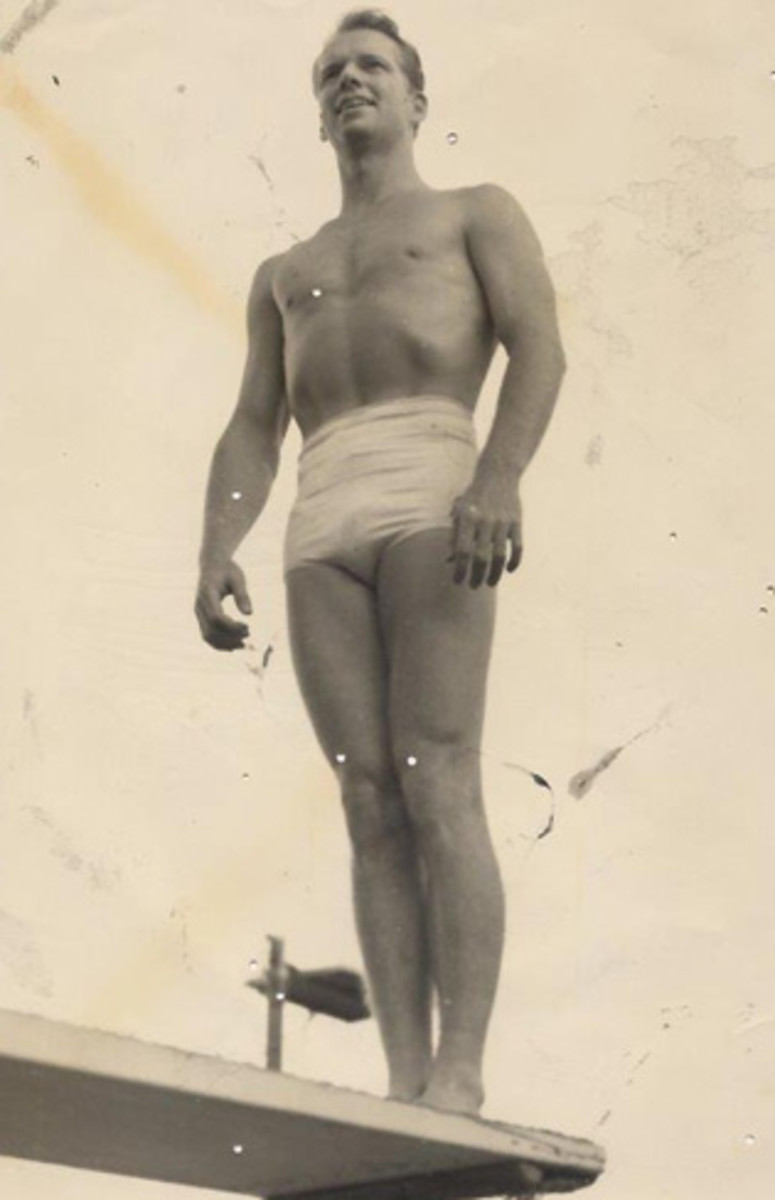
While Marshall Wayne didn't exactly return from Berlin to a hero's welcome, he capitalized on his diving and, of course, his looks. Starting in 1937, he was a star of Billy Rose's Aquacades, a touring troupe that also featured Weissmuller, Buster Crabbe, Esther Williams and Eleanor Holm, the swimmer whose drinking got her banned from the 1936 Games. (In the late '30s, Billy Rose, divorced by his wife, the comedienne Fanny Brice, married Holm. The Brice/Rose divorce figures prominently in the Barbra Streisand movie Funny Lady, and the Holm/Rose divorce 15 years later was referred to in the press as "the war of the Roses.")
Wayne also appeared in advertisements, for Havoline motor oil, BVD underwear, Piels beer and Camel cigarettes. In a Camel ad that ran nationwide, a young woman wearing a form-fitting dress and a come-hither smile approaches Wayne and says, "You always seem to be smoking Camels, Marshall. Do you find them very different from other kinds?" Wayne, clad in a white tuxedo, his hair combed back, replies, "Most divers I know smoke Camels. I certainly do find Camels different, Nora—and from so many angles."
In 1941, though, as war loomed, Wayne quit the Aquacades, deferred his endorsements and enlisted. That fall he completed advanced flight training at Maxwell Field, Ala. Dispatched to Europe, he was forbidden to fly over Germany. If he were captured, the thinking went, his name might be recognized, and he might be tortured or executed.
In the summer of 1943, Stars and Stripes, the military publication, ran a glowing feature on Wayne titled MARSHALL WAYNE NOW DIVING A P38. Wayne was stationed in the U.K. as the commanding officer of the 7th Photo Reconnaissance Group. He and his men flew P-38s, two-engine planes with cameras on the nose that took aerial photographs throughout Europe. (He was also in charge of a fleet of a dozen Spitfires—British single-seat aircraft.) Before the Battle of the Bulge, Wayne flew above the Ardennes. He also flew reconnaissance missions above Normandy. He participated in neither battle, though. In 1944, Wayne was on a mission over Italy when his plane either was shot down or suffered a mechanical problem. Forced to eject, he severely injured his left leg when it was caught in a shroud line. Wayne was fortunate that an Italian family sympathetic to the Allies found him and took him to a British aid station. Once back in England, he spent five months in a hospital.
When the war ended, Wayne returned to South Florida and rehabbed his leg at the Biltmore in Coral Gables. "Every day he went to the beach, sat by the water, let the sand build up and then pushed his leg straight out," recalls his sister. "That's how he got better." Wayne would never dive competitively again, but that was O.K. Flying fed something in him, and his identity no longer revolved around being a diver. "All of my life since the O. Games has been spent as an aviator," he would later write. "[I] didn't land on my ass once, which is a hell of a lot better record than my diving career."
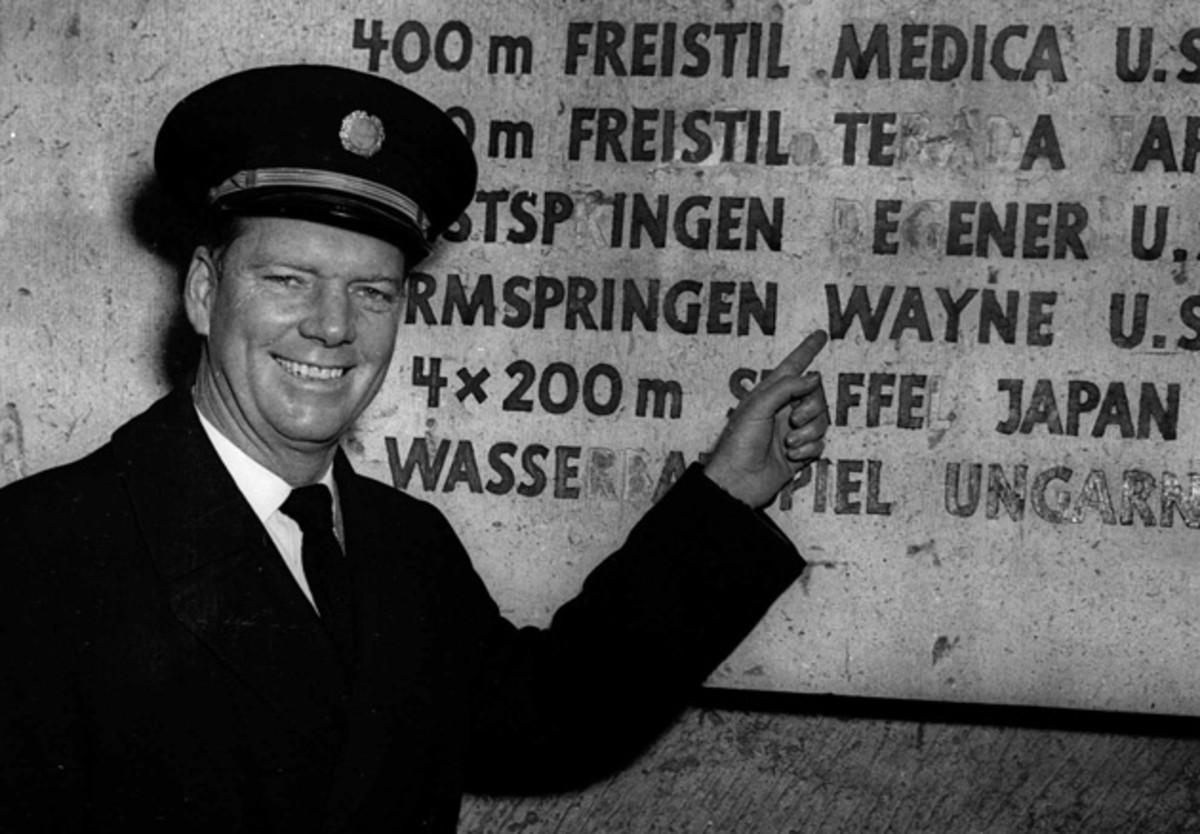
*****
Because of the war, the Olympics were suspended in 1940 and '44, effectively ending Kurtz's diving career as well. The cancellations were deeply disappointing for many other athletes, too, not least two other U.S. divers. Miller Anderson and Sammy Lee were leaders of the next generation of aerialists, close friends united by their drive and their love of diving. During a national meet in '42, Anderson said to Lee, "Let's make a vow that if we both survive [the war], we'll come back and be Olympic champions."
Lee, the son of Korean immigrants, became an Army medical officer at the Port Surgeon's office in Los Angeles. Anderson joined the Army Air Forces and flew a P-47 fighter plane, mostly over Italy. In 1944 his aircraft was hit by flak; in bailing out he clipped the rear of his plane, breaking his left thighbone in midair. When he landed he was captured by German soldiers and taken to a POW camp, where his leg was set incorrectly. Six weeks later Allied troops liberated the camp. Doctors back in the U.S. told Anderson that his leg, badly infected, would have to be amputated. When he refused they reset the leg, inserting a metal plate. Anderson then relearned how to dive, changing his style to avoid putting pressure on the plate.
In 1948 the Olympics resumed, in London. Lee took first in platform diving (becoming the first Asian-American to win an Olympic gold medal) and bronze in the springboard. The silver in the springboard went to ... Miller Anderson. The two friends had kept their pledge.
The overlap between Olympic divers and military pilots is uncanny. David (Skippy) Browning took gold in the three-meter springboard at the 1952 Olympics in Helsinki; he was killed in a Navy jet crash on the Kansas plains two weeks before he was to start training for the '56 Olympics. David McCampbell, naval aviation's "ace of aces," shot down 34 Japanese planes during World War II and was awarded the Congressional Medal of Honor. He was also a diver, for the Naval Academy. Farid Simaika—the Egyptian-born diver who competed against Kurtz in L.A.—was a second lieutenant in WWII, attached to a bomber unit. (In '43, he was shot down over Indonesia and is believed to have been beheaded by Japanese soldiers.) Tom Gompf medaled in the '64 Games in the 10-meter platform; then he was a pilot in Vietnam and later a commercial pilot. And as recently as 2004, Justin Dumais represented the U.S. at the Athens Games, in the three-meter synchronized springboard, before joining the Air Force.
For divers, it seems, becoming a pilot is a natural career extension. In the days before digital technology in the cockpit, the overlap between the disciplines was considerable. In fact, a high-level diver is singularly well-suited to maneuver a plane. His visual awareness, mastery of aerodynamics and understanding of centrifugal force—spinning in midair—are intuitive.
"I don't care who you are," Kurtz is said to have yelled at LBK. "Sit down! Otherwise you're just excess cargo."
"All you need is perfect balance and control," Kurtz said in Queens Die Proudly, W.L. White's book about the war in the Philippines. Bob Clotworthy, a gold medalist diver in 1956 and now the foremost diving historian, puts it this way: "These guys were used to being upside down in the air at a time when not many other people were. They're doing twists and somersaults and acrobatic maneuvers. World War II comes along, who's better to put up there?"
Dumais, now stationed at McEntire Joint National Guard Base in Hopkins, S.C., mostly flies F-16s. He believes diving and aerial combat appeal to people with the same personality traits. "You're doing something very demanding," he says. "It requires a high degree of precision and skill and a lot of training investment—and you're never perfect at it. That describes diving. That describes flying."
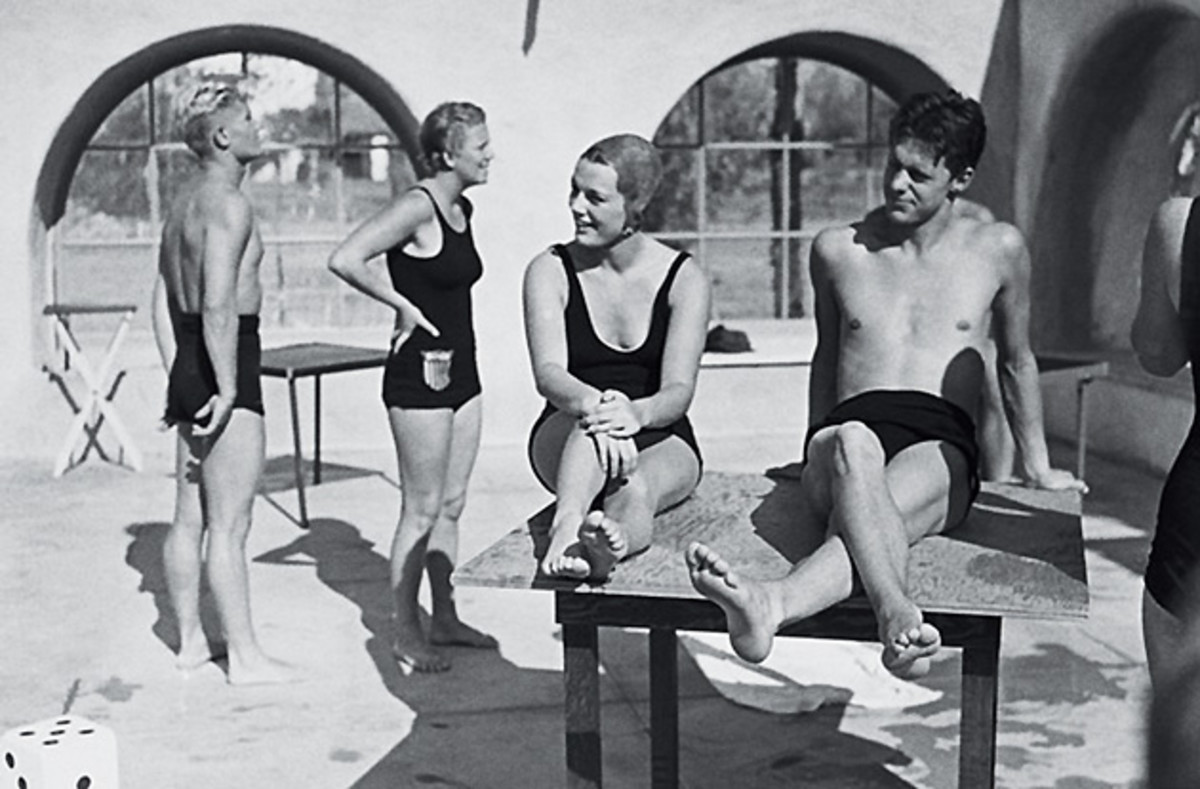
*****
You've served your country with honor? Defeated Hitler and the Nazis? And won medals at the Olympics? What could you possibly do for your next act? What might even come close to replicating the challenge, purpose and exhilaration, the referendum on your manhood, of success in war and Olympic competition?
One of the abiding ironies of the Greatest Generation: Many members derived little pleasure from the simple daily routines—ball games, backyard barbecues, shopping—that they had ostensibly fought to protect. Frank Kurtz and Marshall Wayne were both 33 when the war ended, and they both struggled with the transition to civilian life. It's unlikely that either would have been thought to have PTSD, had the diagnosis existed, but their horizons had narrowed, and they seemed to wear a sort of behavioral camouflage.
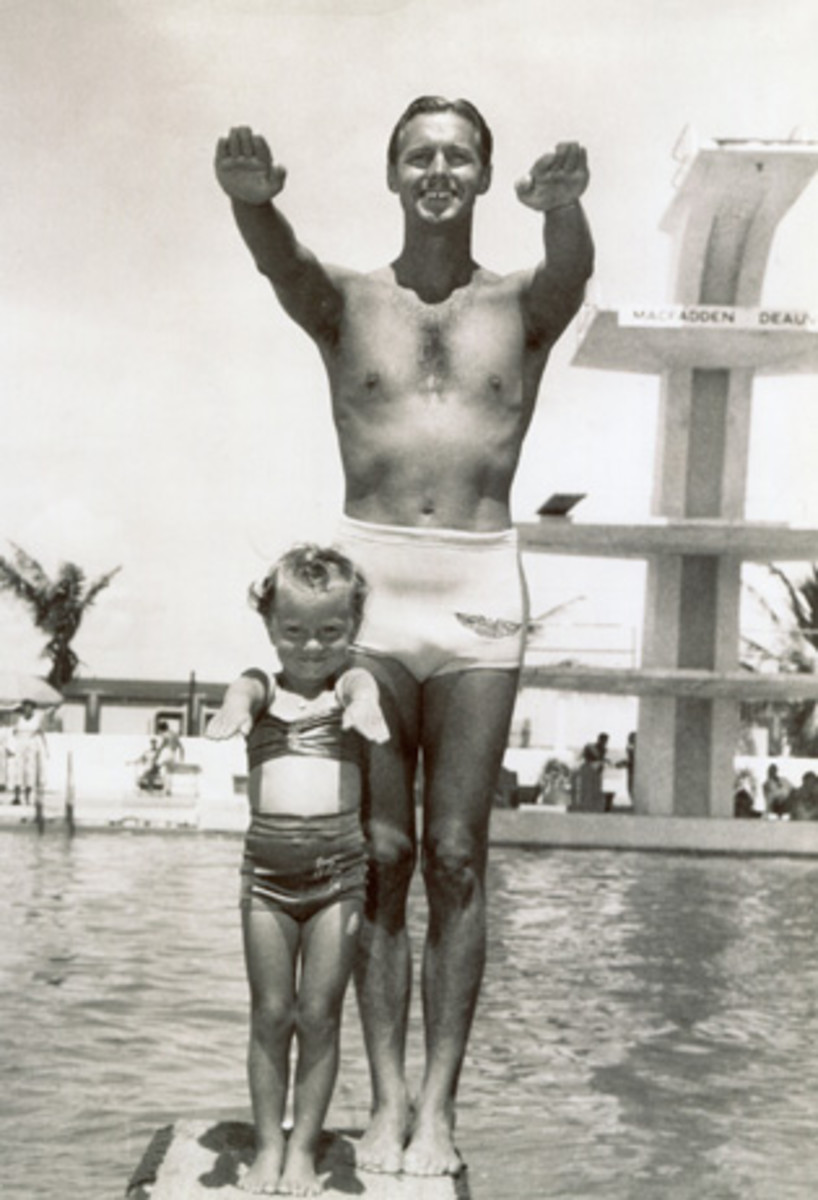
Swoosie Kurtz once described her father to People magazine: "I wouldn't say he was a happy man, no. I think because of the way he grew up, he felt like the world was his enemy in some ways. He was always fighting his own war." When the quote was read back to her recently, she paused and elaborated: "It was the Ticker-Tape Parade Syndrome. What do you do with a hero when you don't need him? He was kind of insular. There was a restlessness. He was great in a crisis. He was less good in everyday life."
Eerily, this echoes what friends and relatives say about Wayne. For decades he'd had a platform—sometimes the 10-meter variety, sometimes the figurative kind, be it the theater of war or a national ad campaign. Without one he was lost. Though profoundly charismatic, he was hard to know. His great-niece Sue Schaefer picks her words carefully as she says, "He was happy when he had people around him, but he did not seek them. They came to him."
Wayne married four times. He had a daughter, Marilyn, who moved to California—she would live a few blocks from Louis Zamperini—though they weren't especially close. Once his leg healed, Wayne spent 27 years as a captain for Pan Am. His modesty faded. Flight attendants on his routes might announce over the P.A. system that the pilot was a war hero and Olympic medalist. When the passengers deboarded, Wayne wasn't above handing out postcards depicting him in his physical prime.
One day, relatives say, Wayne received a new assignment from his supervisor. "You'll be flying our Berlin corridor," the man said. "Are you familiar with it?"
Yes, Wayne responded, in fact he was.
When Marilyn married, in 1970, her father did not attend the wedding. But during her European honeymoon she visited him in Berlin, where he was living. He recounted walking through the airport and being noticed by a traveler, who asked, "Are you Marshall Wayne?"
"I am."
"Well, how about that! Say, what was it like competing in the Jesse Owens Olympics?"
Smiling wryly, Wayne shot back: "Why don't you ask Jesse Owens what it was like competing in the Marshall Wayne Olympics?"
After retiring from Pan Am, Wayne moved to Hendersonville, N.C. When he was inducted into the International Swimming Hall of Fame, in 1980, he didn't attend the ceremony. He passed away in '99, at 87, having kept up his looks until the end. He no longer dived, but he swam daily at a YMCA. Says his sister, "I imagine him pretending he was a teenager, back at the Venetian."
After Kurtz's stint in Europe ended, he was in charge of the fleet of planes that provided air support for the Manhattan Project. He worked at the Pentagon and then returned to L.A., where he held management positions for several corporations, including General Electric. "They were good jobs," says Swoosie, "but the office wasn't for him."
He took pride instead in his family. Frank and Margo were married for more than 50 years, and he derived great pleasure from watching their daughter perform and following her ascending acting career. Sometimes Frank would show up on the set and pilot Swoosie and a few friends to Palm Springs for the weekend in a small plane. "He was kind and gentle and sweet," she says. "People heard about him and expected the Great Santini. He wasn't that at all. But he always wanted structure, always needed a schedule."
In 1995, Kurtz was taking his daily 5:30 a.m. walk in suburban L.A. when he slipped and hit his head on the pavement. Despite a series of surgeries and rehab sessions, he died a year later, at 85.
At the memorial, the family handed out cards bearing a photo of Kurtz in mid-dive: muscled arms splayed and legs stretched, the picture of balance. He is soaring, an unmistakable grin on his face. Why did the family choose that photo? "Because," says Swoosie, "it looks like his body is forming a propeller."
